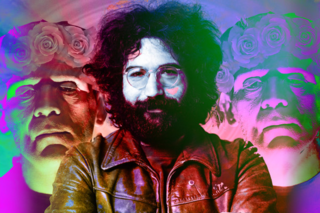Addiction
What Was Jerry Garcia's Addiction?
Cigarettes, sugar, heroin, or music?
Posted June 1, 2017 Reviewed by Lybi Ma

Jerry Garcia died in 1995, age 53. He was in a rehab facility. He died of a heart attack. He was overweight, badly diabetic, and smoked. Being in rehab, he was probably clear of drugs.
To what was Garcia addicted? Or which was his worst addiction? Was it his entire lifestyle? And where did his everlasting love of music fit in?
I just saw the four-hour-plus Grateful Dead documentary, Long Strange Trip, by Amir Bar-Lev. These are the main points I came away with on Jerry's life and death, his and the band's music, his personality, and his addictions.
- Jerry was an outsider who sought release in music as a teenager in high school along with Robert Hunter, who was his chief musical writing collaborator throughout his life, and a young Barbara Meier, whom he met when she was 14.
- Garcia began as a folk guitarist who was carried along to rock and psychedelia by the San Francisco, Haight-Ashbury stream—the band was famous for not being at all interested in commercial success or a recording contract until Warner Brothers came hunting for them.
- They stepped out of type to write the hits I am most familiar with, from the 1970 album American Beauty, almost in a single outburst, perhaps due to feeling indebted for all of the Warner money they had wasted.
- Garcia was both a person who could veer along with a career without planning and yet feel indebted and behave properly within WB—a conflict expressed by one person as "he was clearly the leader but he didn't want to lead" that was tied up with his nervous exhaustion and heroin habit.
- The long-term success of the group, embodied by their simply staying together, was in the fact that the other key players (Bob Weir, Phil Lesh) were, if anything, more malleable than Garcia, who pushed his way to the front musically, but also laid back and allowed others to input, even to dominate, the group's process.
- The nondisease case the film and Garcia's intimates make for his addiction and death was that he was overcommitted to the group's music and preservation and continued financial viability and couldn't leave it even when he was exhausted and his entire life depleted (along with, or which resulted in, his smoking, being overweight, and diabetes).
- The personal portrait of Garcia that emerges from the film is of a non-introspective, despite being very verbal person—his teenage girlfriend, Barbara Meier, a beautiful, articulate woman who loved him—re-entered his life near the end; in one of the mildest interventions of all time, she told him it was okay if he took heroin, but that he had to be honest with her (at this point he was in exceedingly bad health) at which point he kicked her out of their hotel room and she never saw him again.
- The only other family (Garcia was married three times, had other intimate partners and had three daughters) was a daughter shown cataloging his materials and in one home scene; he didn't really talk with her but played music for her and they watched old movies.
- The surviving band members, Bob Weir, Phil Lesh, drummers Mickey Hart and Bill Kreutzmann, along with Hunter, appear to be in good health—although they all (except for Hunter, who elsewhere talks about quitting cocaine) seemed to use psychedelics, cocaine, and smokable heroin, as well as a lot of alcohol.
- The answer seems to be that these core band members survived because they were in some ways essentially healthy—a Deadhead fan illustratively described the difference between using drugs as a window into perception, versus as a protective wall to shut off experience.
- An original band member who died far earlier, in his 20s, was Ron "Pigpen" McKernan; the intricacy of the Weir-Lesh-Garcia musical development and collaboration was something Pig Pen couldn't participate in. He drank himself straight to death. They would never have thrown him out of the band, but it must have been highly demoralizing to have been left by the wayside musically.
- After American Beauty, Garcia and the band spent their lives in endless, expensive, exhausting, sometimes ecstatic touring; yet Garcia and the band and Hunter produced any number of beautiful ballads and they played fascinating, intricately arranged versions of familiar songs; they never seemed to stop working out new arrangements (when they had time to do so, I couldn't tell).
- Garcia had an emphatic philosophy of living in the now, playing for people, rather than creating musical monuments (records)—which Weir and Lesch, and certainly the drummers, all seemed to follow. I have a hard time not viewing that attitude as being a defensive posture towards life, especially in light of the film repeatedly claiming that Garcia just wanted to have fun, and yet he was clearly in so much pain one way and the other towards the end.
- Even as he claims that he wants to be liberated, begs to be free of his financial and professional obligations, Garcia can never leave his music for even a short period—but can something so creative, at which he is so masterful, really be termed an addiction?
- Long Strange Trip (added to the Amy Winehouse documentary, Amy) is the ultimate statement of how addiction, life, and death grow out of a person's, a unit's entire repertoire, relationships, connection to the world and each other, which can't be disentangled and separated into strands that can be repaired individually—addiction and recovery both are life processes.


